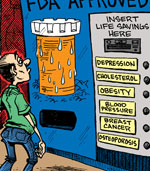Vitamin D and Kids Health Conditions Once Wiped Out, Reappearing in the Twenty-First Century
| Share on Facebook | Share on Twitter | Share on Google+ |
Just 80 years ago, vitamin D for kids changed the course of world history. Prior to 1930, millions of children around the world, but especially in the cloudy, sooty industrial cities of the northeastern United States and northwestern Europe, suffered from a permanently crippling bone deformity disease called rickets. A few drops of vitamin D in milk, it turned out, prevented the condition. In 1920, nearly 80 per cent of children in Boston, Massachusetts had rickets. By 1940, almost none did.
But in the 1980s, however, rickets began to reappear. Children were diagnosed with rickets in places like Cartersville, Georgia, and Mumbai, India, both locations plentiful in sunshine. A disease that once had been thought eradicated was resurfacing, this time not in poor children forced to work in factories, but in children who lived with caring families in comfortable homes with plenty of food to eat. What could be the problem?
Wii, Vitamin D, and Kids
In both the US and India, the occurrence of rickets was found in children who spent almost all their time in centrally air conditioned homes and schools with drapes across the windows, doing homework assignments, surfing the Internet, and playing with Wii. The availability of modern playthings gave these children little reason to go outside and play, and the lack of sunshine depleted their bodies' supplies of vitamin D.
Just a little vitamin D, as little as 200 IU a day, is enough to prevent rickets, but a single dose of 600,000 IU (15 mg) is usually required to treat it. (You should never give a child 600 doses of a 1,000 mg vitamin D tablet. Go to a doctor to get the concentrated vitamin, which is usually given in the doctor's office as six 100,000 IU doses or a single injection.) Moreover, the longer rickets goes untreated, the more likely it is that bone damage will permanent.
When children don't get enough vitamin D, their bones cannot absorb calcium. There is rounding of the shoulders and thickening of the skull, and the legs do not easily support body weight. There can be bowlegs and knock knees.
Since the bones are not absorbing calcium, they also release phosphorous, which strains the kidneys. The intestine cannot absorb essential fatty acids, so there is constant, smelly diarrhea, and liver damage is also common. Disturbances in brain chemistry can lead to seizures.
Which Kids Need Supplemental Vitamin D?
It isn't just children who are hooked on Wii who need supplemental vitamin D. Any child who does not get at least 30 minutes of sunshine a day, or who has dark skin, or his on an exclusively vegan diet may need supplemental vitamin D. Children who are fed a high-corn diet (mealy meal, grits, corn chips, or tortillas) are also susceptible to vitamin D deficiency.
How Much Vitamin D Does a Kid Need?
Preventing rickets is accomplished with just 200 IU of vitamin D. Not getting rickets, however, is the not the only reason to take vitamin D.
Nutrition scientists now recommend that nursing mothers take 4,000 IU of vitamin D, or even more, to ensure their babies get enough vitamin D in breast milk. Human breast milk is great for building the child's immune system, but it naturally contains very little vitamin D. Many of the recent cases of rickets have occurred in dark-skinned children of mothers who exclusively breastfed them. When the child is being breastfed, the mother takes vitamin D, not the child.
The most recent recommendations for vitamin D for babies who are not being breastfed and older children are:
- 0–6 months of age: 1,000 IU
- 6–12 months of age: 1,500 IU
- 1–3 years of age: 2,500 IU
- 4–8 years of age: 3,000 IU
- 9 years of age to adult: 4,000 IU
The easiest way to administer vitamin is in drop form, but it is important to keep vitamin D away from children and to avoid overdose. If you suspect your child has been overdosed with vitamin D, avoid outdoor play for at least a week to prevent sun-induced skin reactions.
Selected References:
Casey CF, Slawson DC, Neal LR. VItamin D supplementation in infants, children, and adolescents. Am Fam Physician. Mar 15 2010;81(6):745-8.
Wagner CL, Greer FR. Prevention of rickets and vitamin D deficiency in infants, children, and adolescents. Pediatrics. Nov 2008;122(5):1142-52.
Zmora E, Gorodischer R, Bar-Ziv J. Multiple nutritional deficiencies in infants from a strict vegetarian community. Am J Dis Child. Feb 1979;133(2):141-4.
-
Skin CareMen Skin Care
-
Free ResourcesFree eBooks
-
Let food be thy medicine, and let thy medicine be food.Hippocrates
-
Featured Health Supplement
 If you find a product that is as effective as Total Balance, and is better value for money, let us know and we will give you a refund equivalent to your entire purchases of Total Balance…retrospective.
If you find a product that is as effective as Total Balance, and is better value for money, let us know and we will give you a refund equivalent to your entire purchases of Total Balance…retrospective.
-



















